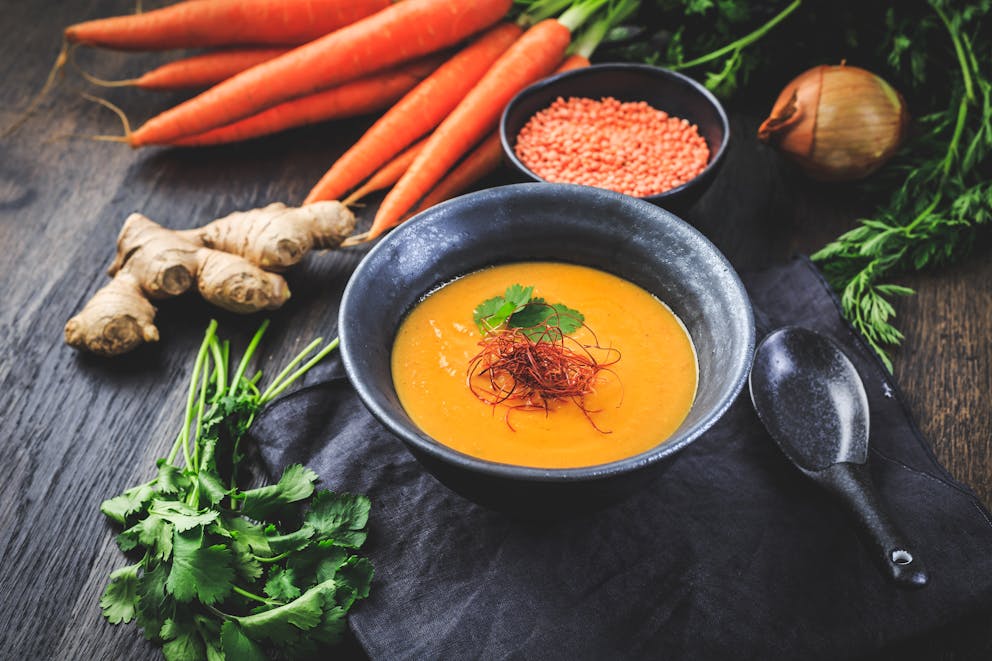Fresh Turmeric Uses – How to Use Turmeric Root at Home
Turmeric, a vibrant yellow spice popular in Indian cuisine, is commonly used to add an earthy flavor and color to a variety of savory dishes.
Curcumin, the primary active ingredient in turmeric, is known for its anti-inflammatory and antioxidant properties and is often utilized in home remedies to manage health issues such as the common cold and sore throats.
Discover some of the best fresh turmeric uses and learn how to store and prepare turmeric root to maximize its impressive health benefits.

Fresh turmeric vs. dried turmeric powder
Turmeric is a spice obtained from the rhizomes of the Curcuma longa plant, which is native to Southeast Asia.
Fresh turmeric root displays a vibrant orange-yellow color and adds a slightly peppery and bold flavor to various dishes.
In contrast, ground turmeric, produced from dried and powdered roots, generally has a milder but somewhat more bitter taste than fresh turmeric.
Fresh turmeric root contains more water and fiber and typically has higher curcumin concentrations than powdered turmeric.
Grated turmeric allows for easy inclusion in various dishes, such as Indian curries and soups.
While both fresh and dried turmeric offer health benefits due to the presence of curcumin, the fresh root is more potent and tends to add more flavor and color to culinary applications.
Ground turmeric, on the other hand, is a convenient and versatile seasoning that’s widely used in dry spice blends.
While fresh turmeric requires refrigeration and has a shorter shelf life, powdered turmeric is shelf-stable.
Fresh turmeric root and dried turmeric powder possess potent anti-inflammatory and antioxidant properties that promote health and well-being when included in a nutritious diet.
However, turmeric has low bioavailability, meaning that curcumin is poorly absorbed due to its fat-soluble properties that slow down intestinal absorption.
"To enhance curcumin absorption, it’s best to combine it with piperine, a phytonutrient found in black pepper," explains Dr. Berg. "Consuming turmeric with healthy fats such as avocados or olive oil or gently heating it also promotes curcumin’s bioavailability."
Watch the video below to discover the impressive health benefits of turmeric.
Health benefits of turmeric root
The turmeric plant has been studied for its various potential medicinal properties, which are primarily attributed to its high concentrations of curcumin.
Here are some of the impressive health benefits of fresh turmeric root:
Anti-inflammatory effects
Antioxidant properties
Potential cardiovascular support
Blood sugar regulation and enhanced insulin sensitivity
Neuroprotective effects and cognitive support
Research published by Dovepress has shown that curcumin may help reduce the risk of various health problems by inhibiting inflammatory pathways and modulating immune responses, which can potentially benefit conditions associated with chronic inflammation, such as rheumatoid arthritis, Crohn’s disease or psoriasis.
In addition, curcumin's antioxidant properties can help combat oxidative stress, thereby protecting cells from damage caused by free radicals.
This antioxidative capacity may have implications for various health conditions, such as improving brain function and lowering the risk of neurodegenerative disorders, including Alzheimer's and Parkinson’s disease.
A study published by Impact Journals: Aging also indicates that curcumin may support heart health by boosting endothelial function, lowering levels of inflammatory markers, and positively influencing factors related to cardiovascular diseases.
Curcumin has been found to promote balanced blood sugar levels and enhance insulin sensitivity and may benefit individuals with diabetes or those at risk of insulin resistance and metabolic syndrome.

7 ways you can use fresh turmeric at home
From soothing beverages such as turmeric tea to enhancing the flavors of stews and even extending to topical uses for skin care, raw turmeric has many different uses.
Here are seven creative ways to incorporate fresh turmeric into your daily routine.
1. Turmeric tea
Make turmeric tea by grating or thinly slicing fresh turmeric root and steeping it in boiling water. Add a dash of ground black pepper to enhance curcumin absorption.
You can customize turmeric tea by incorporating ginger root and fresh lemon juice or prepare it with green tea.
Drinking turmeric tea can help you harness turmeric’s rich anti-inflammatory and antioxidant capacities, which can help relieve pain and support heart health.
2. Golden milk
Golden milk is a comforting beverage made by combining fresh turmeric with unsweetened almond or coconut milk that can be sweetened with manuka honey or monk fruit extract.
This Ayurvedic-inspired drink offers a delightful blend of turmeric’s earthy flavors combined with curcumin's various health benefits, making golden milk a soothing treat before bedtime.
3. Turmeric smoothie
Energize your morning routine by adding fresh turmeric to your smoothie. Blend it with berries, vegetables, and your preferred liquid base.
If the raw turmeric taste is too pungent for you, opt for a high-quality ground turmeric powder instead.

4. Soups and stews
Whether added to a lentil soup, a beef stew, or a hearty chili, fresh turmeric root adds depth of flavors and delivers potential health benefits.
Moreover, slightly heating turmeric helps the absorption of curcumin, making it an excellent ingredient in warm dishes.
5. Sauces and dressings
Finely chop or grate turmeric root and mix it into vinaigrettes, marinades, or dipping sauces. This offers a tasty alternative to many store-bought options, which often are high in sugar, sodium, or preservatives.
Additionally, the vibrant color of turmeric brings a visual appeal to your sauces, elevating both the aesthetic and nutritional value of your meal.
6. Topical skincare
Create a revitalizing face mask by combining grated turmeric root with manuka honey or yogurt.
The anti-inflammatory and antioxidant properties of curcumin can promote a radiant complexion and may help alleviate skin conditions such as acne or eczema.
In addition, mixing turmeric with coconut oil or fresh aloe vera gel may relieve localized skin inflammation or pain when applied topically.
7. Potential remedy for cold and cough
Curcumin’s anti-inflammatory and antioxidant characteristics may relieve sore throats and help combat respiratory discomfort.
Combining turmeric with manuka honey, known for its soothing properties, creates a natural remedy that tastes pleasant and offers potential relief from cold and cough symptoms.

Where to find fresh turmeric root
While most supermarkets stock dried turmeric powder, fresh turmeric roots aren’t as widely available.
Here are a few common places to find fresh turmeric:
Asian market
Farmers market
Online spice shops
Local holistic supermarkets
How to prepare fresh turmeric root
Begin by washing fresh turmeric root under cold water, then use a vegetable peeler to remove the skin.
Once peeled, the root can be grated or thinly sliced, depending on your needs or preferences. Grating the root releases its juices and is ideal for recipes that require a strong turmeric flavor.
Fresh turmeric root is a versatile ingredient that pairs well with various dishes.
Adding a cinnamon stick will introduce a warm, spicy note that complements turmeric's earthy taste in soups such as butternut squash soup.
Grated turmeric also works great with grilled fish dishes and can be combined with fresh ginger for a more subtle and fragrant flavor.

How to store fresh turmeric
Fresh turmeric root can be stored in the refrigerator for up to two weeks. To prolong its shelf life and avoid molding, wrap the root in a paper towel and seal it in an air-tight container or plastic bag.
Alternatively, you can freeze turmeric root for up to eight months. To do so, peel the root, cut it into small pieces, and place them in a freezer-safe bag or container.
However, it’s important to note that freezing can diminish both flavor and potency, and it's best to use fresh or frozen turmeric root immediately.
Possible risks and interactions
While turmeric root is generally safe, excessive consumption may lead to digestive issues such as nausea, abdominal pain, or diarrhea.
Furthermore, turmeric contains oxalates, which are compounds that can contribute to oxalate stone formation, and it’s best to limit the use of turmeric if you are prone to kidney stones.
Before taking turmeric supplements or incorporating fresh turmeric into your daily routine, consult a physician, especially if you have pre-existing health conditions or are taking prescription medications such as blood thinners.
This precaution is crucial since turmeric has been found to possess anticoagulant properties and, if consumed in excess, may potentially increase the risk of bleeding.

Key takeaways
Fresh turmeric root is a versatile ingredient that can be used in cooking, prepared into tea or golden milk, utilized in skincare, and as a remedy for common ailments.
To prolong its shelf life, store fresh turmeric in the refrigerator, where it can be kept for up to two weeks, or freeze it for up to eight months.
FAQ
1. Can fresh turmeric be eaten raw?
Yes, fresh turmeric can be eaten raw and has a slightly peppery flavor.
2. Is fresh turmeric more bioavailable than turmeric powder?
Although fresh turmeric is considered better for overall health due to its higher concentration of curcumin, it may not necessarily be more bioavailable than turmeric powder.
The body absorbs curcumin better when paired with black pepper and healthy fats or by slightly heating fresh or powdered turmeric.
3. How do you prepare fresh turmeric for consumption?
Fresh turmeric can be prepared by thoroughly washing the roots under cold water, peeling the skin, and then grating or thinly slicing it.
Fresh turmeric can be added to various dishes, such as soups, stews, and marinades, to add depth, flavor, and potential health benefits.
4. Can you eat the peel of fresh turmeric?
Yes! There is no harm in eating the peel of fresh turmeric, but due to hygiene reasons, peeling the root before consumption is recommended.
Cleaned properly, the peel can be grated or thinly sliced and added to dishes.
5. What are the top fresh turmeric uses?
Some of the top fresh turmeric uses include adding it to curries, making turmeric and ginger tea, incorporating it into smoothies, using it in soups and stews, and creating homemade curry powder.
6. Which is better, fresh turmeric or turmeric powder?
Both fresh turmeric and turmeric powder have benefits. Fresh turmeric provides a more intense flavor and a higher amount of curcumin, while turmeric powder offers convenience and a longer shelf life.
7. Which recipes call for fresh turmeric root?
There are a variety of recipes that call for fresh turmeric root, such as curries, soups, and salad dressing. It can also be used in shakes, smoothies, and beverages like golden milk and tea.
8. Can I use turmeric powder instead of fresh turmeric in recipes?
Yes, you can use turmeric powder instead of fresh turmeric. However, you may need to adjust the quantity as the flavor intensity can differ.
9. How much fresh turmeric is in one teaspoon of dried turmeric powder?
It is generally recommended to use three times the amount of fresh turmeric for dried turmeric powder.
Therefore, one teaspoon of dried turmeric powder would equal roughly three teaspoons of grated or thinly sliced fresh turmeric.
10. How do you enhance the bioavailability of fresh turmeric?
To enhance the bioavailability of fresh turmeric, it's recommended to combine it with black pepper or healthy fats such as coconut or olive oil.
11. How do you store fresh turmeric root?
It’s best to keep fresh turmeric in the refrigerator. Wrap the root in a paper towel and place it in an air-tight container to prevent moisture from reaching it.
Alternatively, you can freeze peeled and cut turmeric root for up to eight months.
12. How long does turmeric root stay fresh?
Fresh turmeric root can stay fresh for up to two weeks when stored properly in the refrigerator. If frozen, it can last for six to eight months.
However, as time passes, the potency and flavor of turmeric can decrease, and it’s best to consume fresh turmeric root as soon as possible.
Sources
Tags

Popular
08/21/2024
55K views
02/23/2025
46.3K views
11/18/2024
277.7K views
03/18/2024
11/21/2022




